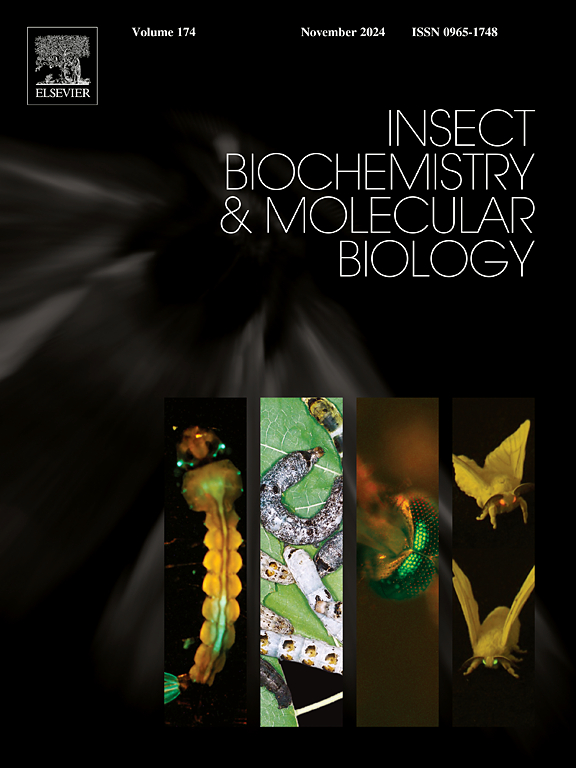趋化激素DH31和Proctolin降低双斑蟋蟀的耐寒性。
IF 3.7
2区 农林科学
Q2 BIOCHEMISTRY & MOLECULAR BIOLOGY
引用次数: 0
摘要
昆虫耐受低温的能力,即耐寒性,有助于它们在全球的分布。然而,昆虫耐寒性的机制仍然知之甚少。在低温下,由于离子和水的平衡被破坏,昆虫进入冷昏迷,一种可逆的麻痹状态。在恢复到正常温度后,昆虫重建和水的平衡,并恢复移动的能力。在这项研究中,我们以双斑蟋蟀Gryllus bimaculatus为实验模型,揭示了神经肽在调节寒冷耐受性中的作用,通常通过从寒冷昏迷中恢复所需的时间来评估。37种神经肽的筛选结果显示,Allatotropin、DH31和Proctolin抑制冷昏迷恢复,降低冷应激下的存活率。RT-qPCR分析显示,Allatotropin和DH31受体主要在后肠表达。注射这三种神经肽可以在低温下减少血淋巴量和肠道水分含量,这很可能是由于它们对直肠收缩的影响,增加了后肠的水分排泄。此外,Allatotropin和DH31是由支配后肠的终腹神经节(TAG)产生的,因为它们部分共定位于TAG,并且在TAG-后肠神经中检测到它们的成熟肽。此外,后肠TAG和受体中神经肽的转录水平随着冷暴露和再暖而改变。基于这些发现,我们认为Allatotropin、DH31和Proctolin会影响肠道(可能是后肠)的生理活动,从而在低温下破坏水分平衡,从而降低蟋蟀的耐寒性。本文章由计算机程序翻译,如有差异,请以英文原文为准。

Allatotropin, DH31, and proctolin reduce chill tolerance in the two-spotted cricket, Gryllus bimaculatus
The ability of insects to tolerate low temperatures, known as chill tolerance, contributes to their global distribution. However, the mechanisms underlying insect chill tolerance remain poorly understood. At low temperatures, insects enter chill coma, a reversible state of paralysis, owing to disrupted ion and water homeostasis. Upon returning to normal temperatures, insects reestablish ion and water homeostasis and recover the ability to move. In this study, we used the two-spotted cricket, Gryllus bimaculatus, as an experimental model and unveiled the roles of neuropeptides in regulating chill tolerance, typically evaluated by the time taken to recover from chill coma. Screening of 37 neuropeptides revealed that Allatotropin, DH31, and Proctolin inhibited chill coma recovery and decreased the survival rate under cold stress. RT-qPCR analyses revealed that the receptors for Allatotropin and DH31 were predominantly expressed in the hindgut. Injection of the three neuropeptides decreased both hemolymph mass and gut water content at low temperatures, most likely by increasing water excretion from the hindgut due to their effects on the rectum contraction. Additionally, Allatotropin and DH31 were produced by the terminal abdominal ganglion (TAG) innervating the hindgut since they were partly co-localized in the TAG, and their mature peptides were detected in the TAG-hindgut nerves. Moreover, the transcriptional levels of the neuropeptides in the TAG and receptors in the hindgut changed with cold exposure and rewarming. Based on these findings, we propose that Allatotropin, DH31, and Proctolin affect the physiological activities of the gut, probably the hindgut, to disrupt water homeostasis at low temperatures, thereby reducing chill tolerance in crickets.
求助全文
通过发布文献求助,成功后即可免费获取论文全文。
去求助
来源期刊
CiteScore
7.40
自引率
5.30%
发文量
105
审稿时长
40 days
期刊介绍:
This international journal publishes original contributions and mini-reviews in the fields of insect biochemistry and insect molecular biology. Main areas of interest are neurochemistry, hormone and pheromone biochemistry, enzymes and metabolism, hormone action and gene regulation, gene characterization and structure, pharmacology, immunology and cell and tissue culture. Papers on the biochemistry and molecular biology of other groups of arthropods are published if of general interest to the readership. Technique papers will be considered for publication if they significantly advance the field of insect biochemistry and molecular biology in the opinion of the Editors and Editorial Board.

 求助内容:
求助内容: 应助结果提醒方式:
应助结果提醒方式:


